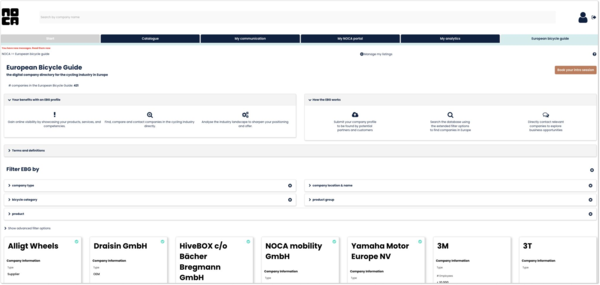This month, we interviewed Anna Buchmann, CEO & Co-founder of NOCA Mobility and active member in CIE's Market Impact & Intelligence, Cycling Innovation Network and Women in Cycling Expert Groups, to share her thoughts on the future and challenges of the cycling industry.
1. Can you give us a brief description of NOCA Mobility?
NOCA mobility is building the digital infrastructure for procurement and supply chain management in the cycling industry. It’s our vision to facilitate the transformation towards sustainable urban mobility by digitalising the value chain for more transparency, efficiency, and resilience.
What does that mean? We are offering component suppliers and OEM vehicle manufacturers a software solution to manage their components/BOMs, orders, data and relationships. This is not to say that we are looking to replace the personal connections the industry is build on and loved for - we rather want to enhance them through digitalisation.
2. What cycling trends are you most excited to see by the year 2030? And by 2050?
I might be a little bit biased since we actually started NOCA to build a cargo bike - four wheels, electric, weather-proof and for individual mobility - before moving into procurement. I am really excited about the cargobike as a sustainable alternative to the car in the city, both for cycle logistics and personal transport. To ensure that the cargobike, and any other bike category for that matter, is competitive in convenience, durability, sustainability, and accessibility, I strongly believe we have to build better processes and become more data-driven as an industry. Here I also believe that "Made in Europe" has its role to play. For that, I am excited to see that increased willingness for data sharing and data analysis is on the horizon for 2030, and that we can do our part with NOCA in this industrial transformation.
As for 2050 - I am excited to be part of an industry that functions as an ecosystem and collaborates when it comes to sustainability and political representation, while getting more people on bikes through competitive and customer-centric offers. I can’t wait to see what new vehicles will be on the road. There is so much more to come in cycling and micromobility that we can’t even imagine yet.
3. What do you see as a major challenge in the cycling industry, and how can CIE play a role in overcoming that challenge?
In my opinion, the cycling industry has to take the next steps to “professionalise” and work together as an industry where it makes sense to become more competitive and create solutions for people who are not riding yet - aka getting more people on bikes. To achieve that, a healthy level of coopetition - the mix between competition and cooperation - needs to be created so that everyone is pulling in the same direction. Here I see great potential for CIE to be a broker within the industry, as well as for the industry in a political context. More specifically:
- Putting cycling on the political agenda: making sure cycling is recognised and supported as an equal (if not prioritised) mode of transport, translating into research funding, economic support, and more and better infrastructure being build.
- (Actionable) data and best practice sharing: creating shared insights through data and offering a space for companies to exchange and learn from each other in a compliant manner to become more efficient, competitive and sustainable as an industry
- Uncovering and shaping collaboration potential: whether it’s new materials, circular business models, or standardisation efforts - there is so much more room for collaboration, but identifying the scope and implementing projects requires time and resources companies often lack. Here I see great potential for the working groups to provide the right frame and accountability/incentives.
In the end, I see CIE’s role as an ecosystem builder, listening to the industry and identifying common challenges and solutions to build a shared growth path.
4. What myth or stereotype about cycling and/or industry needs to be debunked?
That the eBike is only for the lazy and old! I have a surprisingly high number of people in my network that either laugh or scoff at me for riding an ebike. It’s the best purchase I’ve made in the last few years and has given me the freedom to get from point A to B in no time while providing the right balance between movement and not getting too sweaty for the next meeting. Call me crazy - I experience tiny moments of joy when on a Monday morning I overtake fellow cyclists who saw me on my red bike and wildly underestimated my (electrically supported) speed. #coopetition
5. Describe in 5 words how cycling is saving the world
We challenged Anna to tell us in just five words how cycling is saving the world:
NOCA Mobility European Bicycle Guide – CIE Member Special Offer
To facilitate collaboration within the European cycling industry, NOCA launched the European Bicycle Guide - a company directory that helps you find and contact the right partners for your business, including component and service suppliers, OEMs, assemblers and retailers. By creating a company profile, you increase industry visibility and unlock advanced search and contact functions. During the month of March we are offering a launch discount of 20% and with the code CIE10, newsletter subscribers receive an additional 10% off. You can test and sign-up here!

